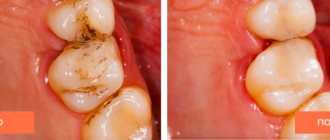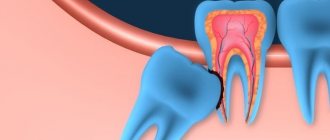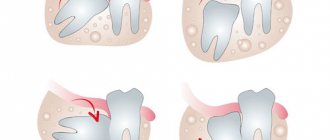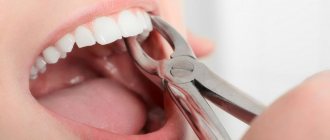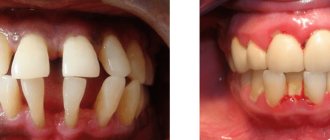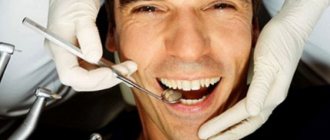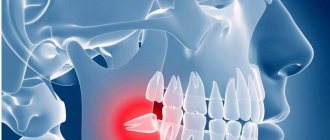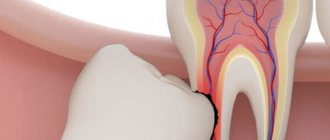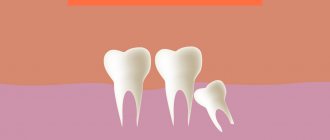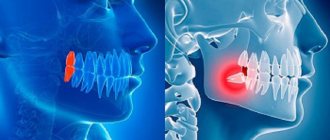In this article
- What is a wisdom tooth and where is it located?
- Why does figure eight caries occur?
- A wisdom tooth affected by caries - treat or remove?
- Pros and cons of treatment tactics for wisdom teeth for caries
- In what cases does wisdom tooth treatment make no sense and must be removed?
- Pros and cons of removal tactics for caries of the lower or upper eights
- Step-by-step treatment of wisdom tooth caries
- How is a wisdom tooth removed?
- Is it necessary to place an implant instead of a removed figure eight?
When caries is detected, there is usually no question of what to do. He is treated immediately. But if caries is found on a wisdom tooth, a person may be faced with a choice - to treat or remove it. We will tell you in this article how to deal with caries of eights correctly.
What is a wisdom tooth and where is it located?
The name “wisdom tooth” is assigned to the third molar, the so-called figure eight, the eighth tooth in a row. The period of wisdom teeth eruption is approximately from 20 to 27 years. In rare cases, they appear after 40 years. It is precisely with the age of eruption that the name of eights—“wisdom teeth”—is associated, because in fact they appear in a person during the period of maximum maturity of the body.
It is interesting that in some people, despite the presence of the rudiments of teeth, they may not erupt throughout their lives. Scientists explain this fact by the fact that in the process of evolution, modern people's jaw has become shorter by about 12 mm compared to their ancestors, which is due to softer food, when chewing which there is no heavy load on the jaw.
If figure eights do erupt, they often cause pain and discomfort to the person. If the jaw is small, then in the process of growth the eights can shift the dentition, which leads to the curvature of other teeth. Therefore, many people try to remove them whenever possible. But the very fact of having a “wise” tooth is not always a reason for its removal.
Structure
Externally, the “eight” is no different from other permanent molars; its uniqueness lies in the following:
- In most cases, teething occurs between the ages of 16 and 25;
- At the moment when the third molar finally appears, the remaining teeth have already taken their places on the jaw, leaving practically no free space. Accordingly, the eighth tooth has to push away its neighbors, which is not always possible;
- Wisdom teeth are extremely difficult to treat because dentists cannot always reach them. And most often, if problems arise with the “eights”, they are simply removed.
Why does figure eight caries occur?
According to statistics, caries of problem eights is much more common than caries of other teeth. At the same time, the main reasons for the development of carious lesions are not much different from those with damage to any other part of the jaw. These include:
- Hereditary factors.
- Poor hygiene.
- Excess sugars and fast carbohydrates in daily nutrition.
- A specific risk factor is the location of the third molar. Typically, the wisdom tooth erupts at an angle, which makes it difficult to properly clean it during daily hygiene procedures. In hard-to-reach areas, food debris accumulates, which serves as a breeding ground for bacteria. By fermenting carbohydrates, bacteria produce organic acid, which leads to caries of the upper or lower 8 teeth.
Hood
As the figure eight erupts, the gums hang over it, forming a pocket, also known in dentistry as a “hood.” Food particles accumulate in this gum pocket, creating fertile ground for the proliferation of harmful bacteria. Sometimes inflammation begins in the “hood”, which can spread to adjacent areas - gums, cheeks, etc. In this case, you should not deal with the problem yourself. Seeing a dentist immediately will help avoid serious complications.
The doctor will perform a hood excision, a small operation in which the gum overhanging the erupting tooth is removed under local anesthesia. The cavity is cleared of purulent discharge and washed with an antiseptic. After the procedure, rinsing with antibacterial drugs may be prescribed, and in the most difficult cases, antibiotics may also be prescribed.
A wisdom tooth affected by caries - treat or remove?
According to statistics, when affected by caries, in approximately 20% of cases, the wisdom tooth can be treated, in 80% it can be removed immediately. The question of treating or removing figure eights is decided by the dentist, taking into account the individual characteristics of a particular patient.
In what cases can experienced dentists treat caries of third molars:
- If the tooth is in satisfactory condition, the carious lesion is superficial or in the stain stage and there are no obstacles to successful treatment.
- It is very desirable to treat wisdom tooth caries if for some reason the patient has had his sixth or seventh teeth removed and the eights bear a large chewing load.
- Treatment of a wisdom tooth affected by caries is also necessary if the figure eights act as a support for orthopedic structures - bridges, crowns.
- Treatment is acceptable if there is no gingival “hood” hanging over the dental crown.
- It is advisable to preserve the tooth even if the opposite jaw also has a figure eight.
Functions
Opinions differ as to why our contemporaries need eighth teeth. Some experts believe that since the “eights” were created by nature and still appear, then they should not be removed unless absolutely necessary. In addition, sometimes the third molar becomes a real lifesaver for fixing a denture. Other doctors are sure that it is better to immediately remove wisdom teeth if they cause concern. After all, these rudimentary organs no longer fulfill their main role - people have long switched to soft foods that have undergone heat treatment.
In what cases does wisdom tooth treatment make no sense and must be removed?
- If the dentist has diagnosed “deep caries of the wisdom tooth,” it makes no sense to treat the disease at this stage. In this case, the tooth is simply removed.
- Figure eights affected by caries are removed if they are incorrectly located in the row of the masticatory-maxillary system.
- Extraction (removal) is carried out for chronic recurrent pericoronitis - if the patient regularly has inflamed gums around the eighth tooth.
- The figure eight should be removed if it injures the soft tissues of the inside of the cheeks. This happens when wisdom teeth are incorrectly positioned.
- Treatment of eighth teeth is not carried out if the patient cannot fully open his mouth or there are other obstacles to the procedure.
- Caries will not be treated if the third molars violate the position of the dentition and cause crowding of the canines and incisors. In such situations, the doctor often removes the figure eights and then performs orthodontic correction of the displaced teeth.
- Basal caries and cervical caries of wisdom teeth are also indications for removal in most cases.
Treatment of complications with the growth of figure eights
The most common complication with the growth of figure eights is pericoronitis
(formation of a gum hood). When a molar erupts, it is forced to overcome many obstacles: the jaw bone, periosteum, and periodontal tissue. During long, complex eruption, a specific mucous canopy (hood) is formed over the molar. Bacteria and food particles penetrate under it, which causes inflammation.
If coronary artery disease is not treated, the consequences will be serious, the inflammation will spread to the periosteum and jaw bone. This is fraught with the development of periostitis, osteomyelitis, tissue suppuration with the formation of phlegmon, cysts, and fistula tracts. Nearby tissues may be affected, and inflammatory ENT pathologies (otitis media, sinusitis) may occur.
Treatment of pericoronitis is surgical and involves excision of the mucous hood. The operation opens access to the growing eight. The doctor removes the affected tissue, carefully treats the surgical area, and evaluates the clinical picture. According to the situation, he decides whether to remove the eights or help the molar to erupt completely, taking the correct place in the row.
Pros and cons of removal tactics for caries of the lower or upper eights
Advantages of the extraction (removal) method:
- it is possible to completely eliminate the infectious focus, prevent the spread of the inflammatory process to adjacent teeth and nearby tissues;
- eliminates the risk of crowded teeth and the need for orthodontic correction;
- the risk of recurrent caries is eliminated;
- removal of the third molar allows you to radically solve the issue of pain in the area of this tooth.
The negative aspects of removing wisdom teeth include the risk of postoperative complications, as well as the inability to install a support for bridges or crowns on the figure eights, if necessary.
Complications: inflammation of the socket, or alveolitis
Inflammation occurs due to infection entering the wound. You should especially beware of it if the process of tooth extraction was traumatic and difficult. Most often the problem occurs for the following reasons:
- disturbance of a blood clot in the wound;
- ingress of tooth fragments or foreign particles into it;
- insufficient sanitation of the resulting hole;
- violation of hygiene recommendations.
Signs of alveolitis may occur 2-3 days after surgery. It is impossible to confuse them with anything. These include pain, inflammation, increased body temperature, an unpleasant odor, and even the discharge of pus. If only one symptom appears, you still need to urgently go to a specialist: the problem will not go away on its own, but will only get worse.
The maximum that a patient can do to avoid complications is to follow all the surgeon’s recommendations, including hygiene ones. But do it in moderation. Take care of yourself and your health!
Step-by-step treatment of wisdom tooth caries
If the dentist gave a positive answer to the question of whether to treat wisdom teeth, it is necessary to begin treatment as early as possible, before caries reaches a more advanced stage. The treatment procedure for third molars is slightly different from the treatment of other teeth in the upper or lower jaw, since due to the special arrangement of the teeth, the doctor cannot use all available technologies.
Treatment occurs in several stages:
- After anesthesia, the dentist carefully prepares the cavity and, using a drill and hand instruments, removes all tissue affected by caries.
- To prevent infection from entering the body, he treats the oral cavity and the tooth itself with an antiseptic solution.
- The dentist places a healing or insulating pad inside the cleaned cavity.
- A seal made of photocomposite material is installed on top of the gasket. It is applied in layers, and each layer is illuminated with a special lamp until completely cured.
- After filling, the tooth is adjusted to the bite, given the correct anatomical shape, ground and polished.
Rehabilitation period
If the operation to remove the “eight” went without complications, healing occurs quite easily. It is only important to follow all the doctor’s instructions, and then you will soon forget that a sore tooth once bothered you.
Among the doctor’s main recommendations are the following:
- Carefully (so as not to remove the blood clot) rinse the mouth with an antiseptic;
- Taking analgesics prescribed by a doctor if necessary;
- Avoid alcohol, smoking, spicy and hot foods on the first day after the procedure;
- Minimizing physical activity immediately after surgery.
How is a wisdom tooth removed?
Depending on a number of factors, the removal procedure can be simple or complex. If there are a small number of roots or their weak connection with the jaw, removing a tooth will not be difficult; the entire procedure will take about 20 minutes.
If the tooth is in the wrong position, has not grown completely, is located under the gum, has fused with the jaw, the roots are intertwined with the roots of other teeth, or a cyst has formed, in such situations the removal procedure will be difficult and will take at least an hour.
Any removal of third molars is a dental procedure performed under local anesthesia. It should be performed by an experienced dental surgeon, so contact only reliable clinics.
The removal procedure occurs in several stages:
- First, an x-ray is taken so that the doctor can understand the exact location of the tooth.
- The specialist selects anesthesia taking into account individual tolerance and gives an anesthetic injection.
- After a few minutes, when the anesthesia takes effect, the removal begins directly. Depending on the complexity, the procedure will take from 20 to 60 minutes.
- The doctor carefully makes incisions, removes the affected wisdom tooth, then treats the jaw with antiseptics and, if necessary, applies stitches.
- After the procedure, the dentist gives recommendations on how to care for your mouth and teeth after surgery. Typically, you should not eat for a couple of hours after the procedure, and you should not rinse your mouth forcefully for a while.
- If inflammation is present, the patient is prescribed antibacterial drugs. They will stop the inflammatory process and prevent the risk of infection spreading to other tissues.
Removal Features
As a rule, operations to remove third molars are always considered difficult, since these are the teeth that usually cause more problems. The operation can be simple, provided that the “figure eight” is located on the upper jaw and does not have pronounced developmental abnormalities. In all other cases (as well as in situations where the tooth is in the upper jaw, but has strong, curved and branched roots), the operation is considered complex and must be performed by a qualified dental surgeon.
Before performing an intervention, the doctor determines possible contraindications for a particular patient, examines an x-ray of the problem area and determines the optimal tactics for the operation. The duration of the procedure ranges from 1-10 minutes for simple removal and up to 20-120 minutes for complex removal, requiring a series of manipulations and suturing of the hole.
Is it necessary to place an implant instead of a removed figure eight?
Theoretically, a dental implant can be placed in place of an extracted wisdom tooth that has been affected by caries. But in practice this is not done for a number of reasons. Firstly, the anatomical location of the tooth makes such implantation extremely difficult. Secondly, the load on the eighth tooth will sooner or later lead to loosening of the rod on which the implant is attached. Food will get into the gaps formed and microbes will multiply, which can lead to inflammation. Thirdly, even with proper installation of the implant, there will still be a joint between the gum and the crown, in which bacteria will accumulate if hygiene is difficult.
And finally, replacing a removed figure eight with an implant does not make practical sense, especially if a person’s other chewing teeth function normally. Also, the absence of these teeth does not impair the quality of life and does not affect human health. Therefore, after removing the third molar, there is no need to install an implant in its place.
Lifespan
Despite the fact that third molars erupt later than other teeth, they do not last long. This is often due to the fact that figure eights are difficult to care for due to the difficulty of accessing them with a toothbrush (for the most part this applies to teeth growing at an angle). As a result, the eighth teeth deteriorate and are removed.
It happens that “eights” are affected by caries even before the moment of complete eruption, as a rule, if it lasted a long time and was accompanied by complications. But completely opposite situations are also known, when wisdom teeth do not cause any trouble to their owner. The latter option is explained by the correct placement of the “eights” and regular oral care.
